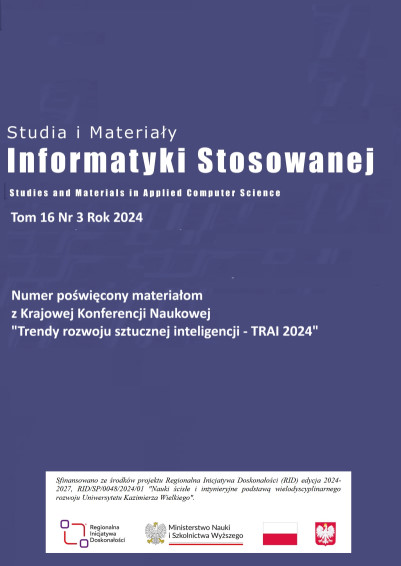Kolmogorov-Arnold networks for metal surface defect classification
DOI:
https://doi.org/10.34767/SIMIS.2024.03.08Keywords:
Kolmogorov–Arnold Networks, KAN, Classification, Metal surface defects, Artificial Neural NetworksAbstract
This paper presents the application of Kolmogorov-Arnold Networks (KAN) in classifying metal surface defects. Specifically, steel surfaces are analyzed to detect defects such as cracks, inclusions, patches, pitted surfaces, and scratches. Drawing on the Kolmogorov-Arnold theorem, KAN provides a novel approach compared to conventional multilayer perceptrons (MLPs), facilitating more efficient function approximation by utilizing spline functions. The results show that KAN networks can achieve better accuracy than convolutional neural networks (CNNs) with fewer parameters, resulting in faster convergence and improved performance in image classification.
References
Krzywda M., Lukasik S., Gandomi A.H. Graph Neural Networks in Computer Vision - Architectures, Datasets and Common Approaches. 2022 International Joint Conference on Neural Networks (IJCNN), 1-10.
Krzywda M., Łukasik S., Gandomi A.H.. Cartesian Genetic Programming Approach for Designing Convolutional Neural Networks. ArXiv 2024, arxiv.org/abs/2410.00129.
Lv X., Duan F., Jiang J.J., Fu X., Gan L. Deep metallic surface defect detection: The new benchmark and detection network. Sensors 2020, 20(6), 1562.
Calin O. Deep learning architectures. New York City: Springer International Publishing 2020.
Chazhoor A.A.P., Ho E.S., Gao B., Woo W.L. A review and benchmark on state-of-the-art steel defects detection.SN Computer Science, 2023, 5(1), 114.
Liu Z., Wang Y., Vaidya S., Rehle F., Halverson J., Soljačić M., Tegmark M. KAN: Kolmogorov-Arnold Networks. arXiv preprint 2024. arXiv:2404.19756.
Schmidt-Hieber J. The Kolmogorov–Arnold representation theorem revisited. Neural networks, 2021, 137, 119-126.
Shukla K., Toscano J.D., Wang Z., Zou Z., Karniadakis G.E. A comprehensive and FAIR comparison between MLP and KAN representations for differential equations and operator networks. arXiv preprint 2024. arXiv:2406.02917.
Yu R., Yu W., Wang X. KAN or MLP: A fairer comparison. arXiv preprint 2024. arXiv:2407.16674.
Ha W., Yizhou W., Yaqin L., Zhili S. The role of activation function in CNN. In 2020 2nd International Conference on Information Technology and Computer Application (ITCA) (pp. 429-432). IEEE 2020.
Yuen B., Hoang M.T., Dong X., Lu T. Universal activation function for machine learning. Scientific reports, 2021, 11(1), 18757.
Bao Y., Song K., Liu J., Wang Y., Yan Y., Yu H., Li X. Triplet-graph reasoning network for few-shot metal generic surface defect segmentation. IEEE Transactions on Instrumentation and Measurement, 2021, 70, 1-11.
Grishin A., Boris V., Bardintsev O. Severstal: Steel Defect Detection. Kaggle. 2019.
Deshpande A.M., Minai A.A., Kumar M. One-shot recognition of manufacturing defects in steel surfaces. Procedia Manufacturing, 2020, 48, 1064-1071.
Bodner, A.D., Tepsich, A.S., Spolski, J.N., Pourteau, S. Convolutional Kolmogorov-Arnold Networks. arXiv preprint 2024. arXiv:2406.13155.
Kuntur S., Wróblewska A., Paprzycki M., Ganzha, M. Under the Influence: A Survey of Large Language Models in Fake News Detection. IEEE Transactions on Artificial Intelligence 2024.
Downloads
Published
Issue
Section
License

This work is licensed under a Creative Commons Attribution-ShareAlike 4.0 International License.

